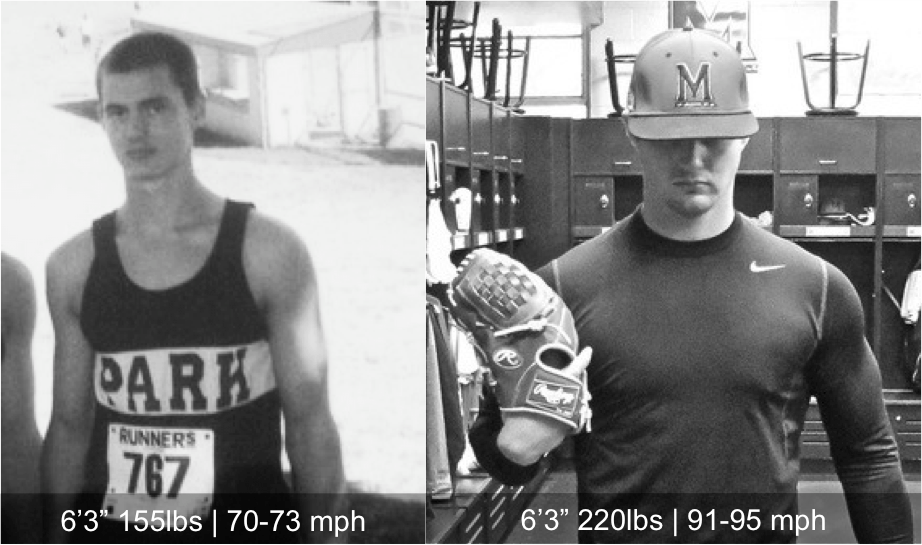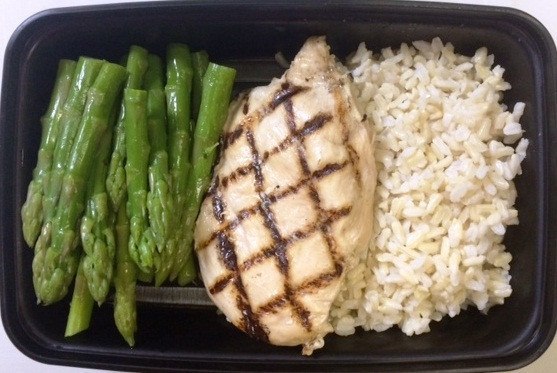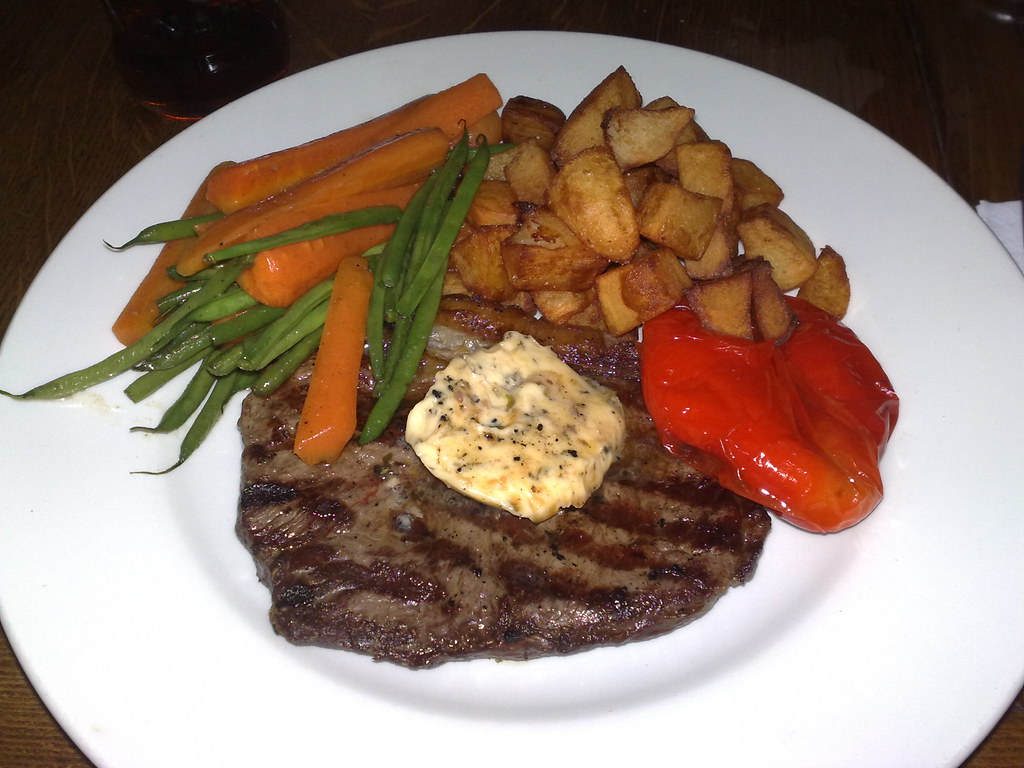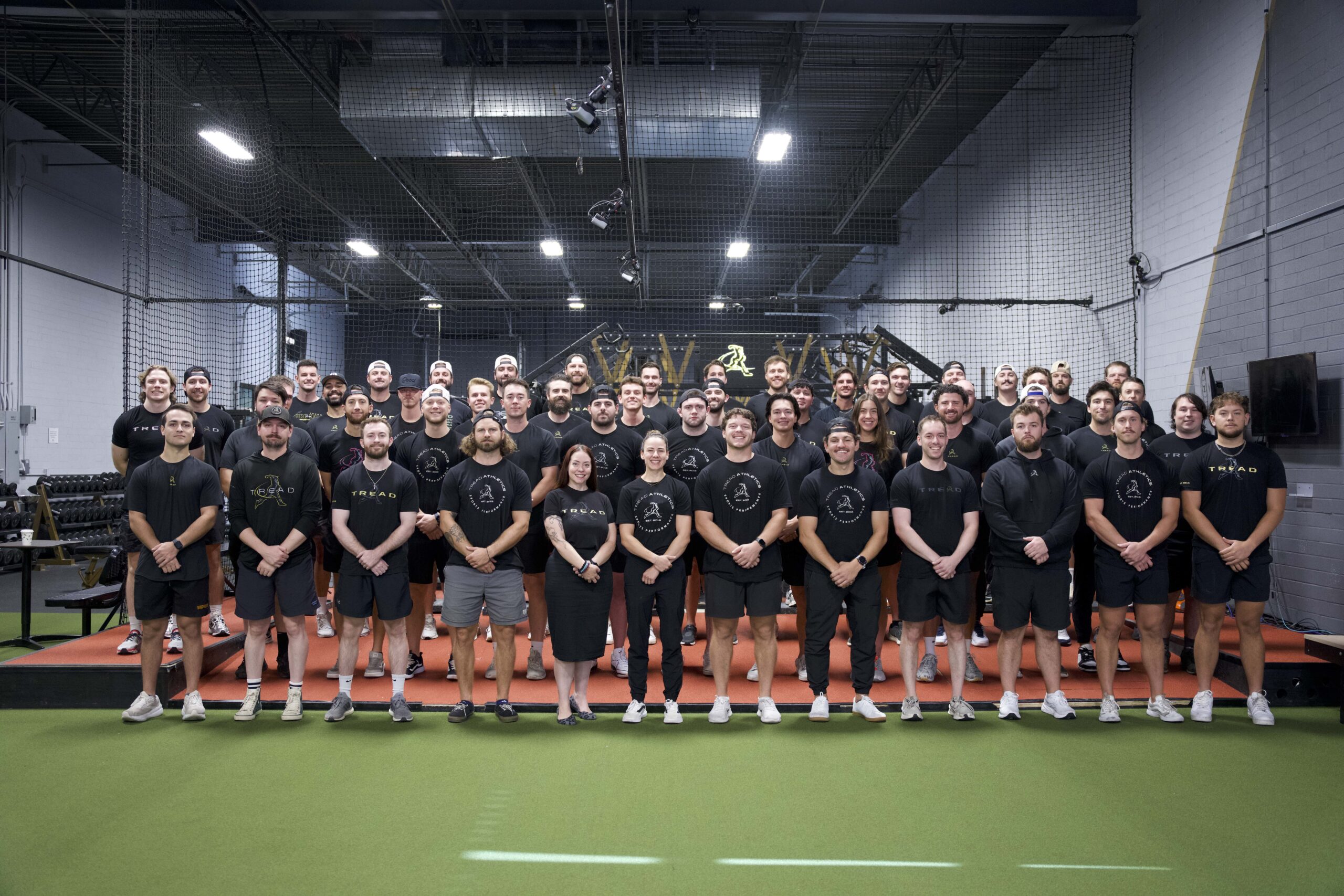It’s that time of year again – the heart of the offseason. These are the precious short months where true progress can be made both in the weight room and the kitchen to a competitive pitcher’s body. Unfortunately, most skinny pitchers continue to make the same basic mistakes year after year, declaring that they can’t gain weight and blaming their genetics for their struggles.
While genetics do play a role in your ability to gain muscle mass, most people are nowhere close to their genetic limit. Can you guess who this handsome devil 6’3″ 155 pounder on the left was?
To the right is also me, 65 pounds heavier.
I have never worked with an athlete who has been unable to put on weight, size and strength (in fact, many of our skinny pitchers who swore they could never gain weight put on 15-25 lbs in their first 3 months). Here is a countdown of the 6 most common way pitchers unknowingly cripple their ability to put on size, strength and velocity.
—
#6 They ignore the principle of progressive overload
Breaking news: showing up to the weight room 3-4 times per week doesn’t guarantee progress. Most pitchers assume that by consistently showing up and following any old program, they will be optimizing their strength, size and athleticism. This isn’t how physiology works.
Getting stronger and stimulating muscle growth (hypertrophy) requires an overload stimulus (increased volume, intensity or both). This is all well and good, except for the fact that many coaches don’t track progress. No, I’m not talking about the personal trainer named Paulo who works at your local Planet Fitness. There are college – and even some professional teams who don’t use tracking charts or monitor if progress is being made. But I digress…
This is training blind.
An athlete needs to be able to follow a planned progression for each movement and/or muscle group, AND his coach must have a way of evaluating how well that progression is actually working.
This goes for accessory movements too.
How are you progressing your external rotation work? Just doing 3 sets of 10 with a light band will stop providing benefit after a certain point. What about abdominal work? Many coaches progress their main lifts and fail to plan out progressions for accessory lifts – if an exercise is worth including in a training program, it’s worth progressing.
Example: Weighted Front Plank Progression
Week 1: 4x:30 w/ 45 lbs
Week 2: 2x:30 w/ 60 lbs, 2x:45 w/ 45 lbs
Week 3: 2x:30 w/ 75 lbs, 2x:60 w/ 45 lbs
Week 4: 2×30 w/ 90 lbs, 2×30 w/ 60 lbs
Etc.
This leads into number five…
—
#5 They vary up their training too much
The need for exercise variety is vastly overblown in the sports performance industry.
When I worked with Christian Meister, helping get him from 205 to 215 lbs in roughly 6 weeks (and from 96 to 100 mph on pull downs in that time), we used FOUR primary exercises in a very basic, 3-day-per week program.
> His box squat went from 185 lbs for 5 to 275 lbs for 5.
> His dumbbell bench went from 60lbs for 8 to 80lbs for 8
> His dumbbell row went from 70 lbs for 8 to 100 lbs for 8
> His barbell lunges went from 125 lbs for 6 to 185 lbs for 6.
Again, all of this was in under 6 weeks.
We continued progressing all of his arm care and scapular integrity work as well, but for him the goal was keeping it simple and effective.
Does this mean that exercise variety has no value? Of course not! But rotating exercises too frequently can make progress difficult to measure.
Once you find your bread-and-butter movements, stick to them and give them time to progress. Varying volume, intensity, tempo, etc. in these movements within a planned progression will benefit an athlete more than mixing up his exercises every time progress stalls.
—
#4 They have no idea what they are training towards
“If you don’t know where you are going, any road will get you there.” -Lewis Carroll
Athletes and coaches need to be on the same page. What is the end goal of this training phase? Of the entire offseason?
Pitchers always seem to want big biceps need goal numbers to work towards on each of their lifts. Understanding how to set realistic goal metrics for each individual is a critical coaching tool for getting the most out of each player.
Suddenly, Johnny Wholestaff isn’t just squatting to squat. He is squatting to get his max from 275lbs to 315lbs in 12 weeks, knowing that larger and more powerful hip and knee extensors will help propel him more explosively down the mound and potentially aid his throwing velocity.
—
#3 They lie to themselves that they eat a lot
This one is a bit misleading. It’s not that pitchers who struggle to gain weight are not trying their best to eat a lot of food, it’s that they are going about it the wrong way.
They may be eating “a lot” of food relative to what they usually eat, or relative to what their buddies eat. Their body may be giving signals of fullness too, which leads pitchers to assume they are eating “enough.”
The issue with this approach is, of course, subjectivity.
For hardgainers, especially those with small appetites, relying on the body’s own regulatory mechanisms is ineffective. The body will try to resist change via overfeeding through feelings of fullness, increases in metabolism, and others.
[thrive_text_block color=”blue” headline=””] The best way to ensure a consistent caloric surplus is for pitchers to actually track what they are eating and how their bodyweight and strength metrics are responding.[/thrive_text_block]
Again, this comes back to tracking everything so that when something doesn’t progress as planned, you can make an informed adjustment to the plan.

—
#2 They focus on eating only “clean” foods
The volume of the food you’re eating doesn’t matter as much as the caloric density of that food. There’s a reason veggies, chicken breast, oatmeal and rice are classic fat-loss foods: they are extremely filling relative to the calories they provide. Good luck eating 1,500 calories of chicken breast and rice for dinner, months on end. It’s not going to happen.
Instead, place a larger emphasis on calorie dense foods. Chicken thighs over chicken breasts, full fat dairy over low fat dairy, you get the idea. At the end of the day, calories in vs. calories out decide if a pitcher is gaining weight or not.
Not necessarily the foods to be basing a 4,000+ calorie diet around.
—
*Gasp* did you just say not to eat clean foods?
Not at all! We still encourage our athletes to eat these types of foods, but many find it difficult to hit high calorie goals if this is all that they are eating. What I’m getting at is that the concept of “clean” vs. “dirty” is flawed. Remember, very few foods are actively bad for us – in moderation. What we are really talking about is nutrient density and caloric density. “Dirty” foods tend to be highly processed foods that have low nutrient density and high caloric density – while small amounts of these types of foods in the midst of a well balance diet won’t hurt performance, basing an entire daily intake around these can lead to deficiencies. “Clean” foods tend to be unprocessed foods that have high nutrient density and low caloric density. This isn’t ideal for gaining weight either, if it’s all an athlete consumes.
While neither “clean” nor “dirty” foods need be 100% avoided, we recommend basing the bulk of the diet around minimally processed foods that have high caloric density – full fat meats, nuts, cottage cheese, Greek yogurt, milk and avocados.
That’s more like it
—
The 80-20 rule
Processed foods are not inherently harmful. The issue with eating a largely processed-food diet is that it can lead to macronutrient and micronutrient deficiencies. However, for an individual on an extremely high calorie diet that is based around whole foods, this is rarely an issue. As such, it can be helpful to allow some flexibility within which foods are allowed if it means the difference between a pitcher hitting their calorie goals or not by the end of the day.
We recommend that 80% of the diet come from whole foods, and up to 20% come from foods that would otherwise not be “allowed” – pizza, ice cream, whatever it takes to hit a calorie and macronutrient goal at the end of the day, within reason. We aren’t talking about excessive binge eating to 8,000 calories or 75% of ones diet sliding towards these types of foods.
Picture the athlete who struggles to gain weight and is deciding whether to go to sleep at 3,600 calories on the day or push to his goal of 4,200. In this case, crushing a milkshake is a far better option than missing out on those calories altogether.
—
#1 They don’t bring food with them wherever they go
Have you ever tried eating 4 or 5,000 calories a day while spending 4 hours in class and 5 hours at the baseball field? It’s not easy.
Given that most athletes settle into the norm of eating just three meals per day, this would mean absurdly sized meals.
As a general rule of thumb, you should be eating at least one meal per 800-1,000 calories of your daily goal. This means at LEAST 5 large meals for a 5,000 calorie goal, 4 large meals for a 4,000 calorie goal, etc.
Doing this on the go doesn’t have to be tough – here are some food options for pitchers to keep in their bags for quick 800-1,000+ calorie meals on the go.
—
1,000 calorie meals in 10 minutes or less
> 2.5 peanut butter sandwiches (~900 calories)
> 2 granola bars (~400 calories), 2 flour tortillas (~400 calories), 1 large handful trail mix (~200 calories)
> 16 oz. chocolate milk (~400 calories), 3 large handfuls of trail mix (~600 calories)
—
If pitchers keep these types of items with them at ALL TIMES, there is never an excuse to not get their calories in. I have athletes who scarf down handfuls of trail mix in between sets during their training sessions, finishing with an effortless extra 800 calories on the day.
Keep in mind, this approach still assumes 3 large, square, whole food meals each day – these snacks are for those sometimes tough-to-squeeze-in 4th or 5th meals that most pitchers end up skipping.
—
You have to want it.
At the end of the day, some pitchers simply won’t be willing to do what it takes to put on weight. It’s easy to bring energy for 90 minutes, 4 days a week in training. It’s much more difficult to pay attention every other waking minute to the fuel you put into your body, getting to bed on time, and doing the unsexy work that differentiates the good from the great.
This, more than anything, is what separates those who want it, from those who are content to continue gliding by on whatever natural talent they have.
There are so many athletes who have all the talent in the world, but simply aren’t willing to make themselves uncomfortable.
It’s not easy, and that’s the point.
The sooner your pitchers start treating their weight gain as an all-out battle, the sooner they will start seeing those self-imposed barriers crumble.
It’s time to get to work.
—
Like what you read? Help us grow our reach by sharing it on social media! Thanks for reading.








